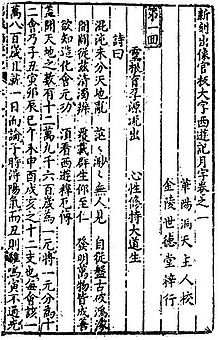
Back Die reis na die weste Afrikaans رحلة إلى الغرب Arabic Viaxe al Oeste AST Көнбайышҡа сәйәхәт Bashkir Падарожжа на Захад Byelorussian ༼ནུབ་ཕྱོགས་སུ་བསྐྱོད་པའི་རྣམ་ཐར།༽ Tibetan Viatge a l'Oest Catalan Să̤-iù-gé CDO گەشت بەرەو ڕۆژاوا CKB Putování na západ Czech
 Earliest known edition of the book, published by the Shidetang Hall of Jinling, from the 16th century | |||||||||||||||||||||||||||
| Author | Wu Cheng'en | ||||||||||||||||||||||||||
|---|---|---|---|---|---|---|---|---|---|---|---|---|---|---|---|---|---|---|---|---|---|---|---|---|---|---|---|
| Original title | 西遊記 | ||||||||||||||||||||||||||
| Language | Chinese | ||||||||||||||||||||||||||
| Genre | Gods and demons fiction, Chinese mythology, fantasy, adventure | ||||||||||||||||||||||||||
| Set in | Tang dynasty, 7th century AD | ||||||||||||||||||||||||||
Publication date | c. 1592 (print)[1] | ||||||||||||||||||||||||||
| Publication place | Ming China | ||||||||||||||||||||||||||
Published in English | 1942 (abridged) 1977–1983 (complete) | ||||||||||||||||||||||||||
| 895.1346 | |||||||||||||||||||||||||||
Original text | 西遊記 at Chinese Wikisource | ||||||||||||||||||||||||||
| Chinese name | |||||||||||||||||||||||||||
| Traditional Chinese | 西遊記 | ||||||||||||||||||||||||||
| Simplified Chinese | 西游记 | ||||||||||||||||||||||||||
| Literal meaning | "Record of the Western Journey" | ||||||||||||||||||||||||||
| |||||||||||||||||||||||||||
| Vietnamese name | |||||||||||||||||||||||||||
| Vietnamese | Tây du kí | ||||||||||||||||||||||||||
Journey to the West (Chinese: 西遊記; pinyin: Xīyóu Jì) is a Chinese novel published in the 16th century during the Ming dynasty and attributed to Wu Cheng'en. It is regarded as one of the great Chinese novels, and has been described as arguably the most popular literary work in East Asia.[2] It is best known in English-speaking countries through Arthur Waley's 1942 abridged translation, Monkey.
The novel is a legendary account of the pilgrimage of the Chinese Buddhist monk Xuanzang, who journeyed to India in the 7th century AD to seek out and collect Buddhist scriptures (sūtras).[3] The novel retains the broad outline of Xuanzang's own account, Great Tang Records on the Western Regions, but embellishes it with fictional fantasy elements from folk tales and the author's invention. The Buddha tasks the monk, named "Tang Sanzang" or "Tripitaka", with journeying to India and provides him with three protectors who agree to help him in order to atone for their sins: Sun Wukong (the "Monkey King"), Zhu Bajie, and Sha Wujing. Riding a White Dragon Horse, the monk and his three protectors journey to a mythical version of India and enlightenment through the power and virtue of cooperation.
Journey to the West has strong roots in Chinese folk religion, Chinese mythology, Chinese Buddhism, Confucianism, Taoist and Buddhist folklore, and the pantheon of Taoist immortals and Buddhist bodhisattvas are still reflective of certain Chinese religious attitudes today, while being the inspiration of many modern manhwa, manhua, manga and anime series. Enduringly popular,[4] the novel is at once a comic adventure story, a humorous satire of Chinese bureaucracy, a source of spiritual insight, and an extended allegory.
- ^ Yu (2012), p. 18.
- ^ Kherdian, David (2005). Monkey: A Journey to the West. p. 7.
is probably the most popular book in all of East Asia.
- ^ "Journey to the West | Author, Summary, Characters, & Facts | Britannica". www.britannica.com. 21 August 2024. Retrieved 21 August 2024.
- ^ "Monkeying Around with the Nobel Prize: Wu Chen'en's "Journey to the West"". Los Angeles Review of Books. 13 October 2013.
It is a cornerstone text of Eastern fiction: its stature in Asian literary culture may be compared with that of The Canterbury Tales or Don Quixote in European letters.
© MMXXIII Rich X Search. We shall prevail. All rights reserved. Rich X Search